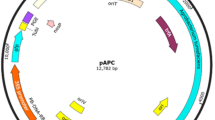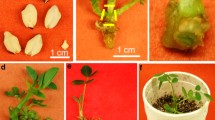Abstract
This study was conducted to obtain intron-GUS gene-transferred plants by using somatic embryos (including embryogenic calluses) derived from 2 in vitro root explants of breeding lines (KR056002 and KR056006) bred by crossing between Rosa hybrida ‘Tineke’ and ‘Mirinae Gold’. Calluses were induced from their root explants cultured in Schenk and Hildebrandt (SH) medium, which was supplemented with 5 or 11 mg·L−1 of 2,4-dichlorophenoxyacetic acid (2,4-D). Somatic embryos were generated from the calluses, which were cultured in SH medium supplemented with 3 mg·L−1 of 2,4-D. The ratio of callus formation from in vitro root explants was dependent on the concentration of 2,4-D supplement in the SH medium. Somatic embryos were generated from both KR056002 and KR056006, and embryogenesis was observed from calluses around the somatic embryo. The regenerative capacity of the embryo was maintained longer in calluses derived from in vitro root explants cultured on SH medium supplemented with 11 mg·L−1 of 2,4-D than with 5 mg·L−1 of 2,4-D. Six pseudo-intron-GUS transgenic lines were obtained. The expression rate of the intron-GUS gene in multi-shoots was 100%. After the formation of healthy roots, 3 transgenic lines were transferred to the greenhouse. All 3 lines were reconfirmed as intron-GUS gene transgenic plants by PCR and Southern analyses.
Similar content being viewed by others
Literature cited
Derk, F.H.M., A.J. van Dijk, C.H. Hanisch ten Cate, D.E.A. Florack, L.A.M. Dubois, and D.P. de Vries. 1995. Prolongation of vase life of cut roses via introduction of genes coding for antibacterial activity, somatic embryogenesis and Agrobacterium-mediated transformation. Acta Hort. 405:205–209.
Dohm, A., C. Ludwig, K. Nehring, and T. Debener. 2001. Somatic embryogenesis in roses. Acta Hort. 547:341–347.
Doyle, J.J. and E.E. Dickson. 1987. Preservation of plant samples for DNA restriction endonuclease analysis. Taxon 36:715772.
Dubois, L.A.M. and D.P. de Vries. 1995. Preliminary report on the direct regeneration of adventitious buds on leaf explants of in vivo grown glasshouse rose cultivars. Garrenbauwissenschaft 60:249–253.
Firozabody, E., Y. Moy, N. Courtneygutterson, and K. Robinson. 1994. Regeneration of transgenic rose (Rosa hybrida) plants from embryogenic tissues. Bio/Technology 12:609–613.
Foster, E., D. Schneiderman, M. Cloutier, S. Gleddie, and L.S. Robert. 2002. Modifying the pollen coat protein composition in Brassica. Plant J. 31:477–486.
Hsia, C. and S.S. Korban. 1996. Organogenesis and somatic embryogenesis in callus of Rosa hybrida and Rosa chinensis minima. Plant Cell Tiss. Organ. Cult. 44:1–6.
Ibrahim, R. and S.S. Debergh. 2001. Factors controlling high efficiency adventitious bud formation and plant regeneration in vitro leaf explants of roses (Rosa hybrida L.). Sci. Hort. 88:41–57.
Jefferson, R.A., T.A. Kavanagh, and M.W. Bevan. 1987. GUS fusions: -glucuronidase as a sensitive and versatile gene fusion marker in higher plants. EMBO J. 6:3901–3907.
Kamo, K., B. Jones, J. Bolar, and F. Smith. 2005. Regeneration from long-term embryogenic callus of the Rosa hybrida cultivars Kardinal. In Vitro Cell Dev. Biol. Plant 41:32–36.
Kim, C.K., J.D. Chung, S.O. Lee, and J.Y. Oh. 2003. Somatic embryogenesis from in vitro grown leaf explants of Rosa hybrida L. J. Plant Biotech. 5:169–172.
Kim, C.K., J.D. Chung, S.H. Park, A.M. Burrell, K.K. Kamo, and D.H. Byrne. 2004. Agrobacterium tumefaciens-mediated transformation of Rosa hybrida using the green fluorescent protein (GFP) gene. Plant Cell Tiss. Organ. Cult. 78:107–111.
Kim, S.W., M.J. Oh, and J.R. Liu. 2009. Plant regeneration from the root-derived embryogenic tissues of Rosa hybrida L. cv. Charming via a combined pathway of somatic embryogenesis and organogenesis. Plant Biotechnol. Rep. 3:341–345.
Lee, S.Y., J.H. Jung, J.H. Kim, and B.H. Han. 2008. In vitro multiple shoot proliferation and plant regeneration in rose. J. Plant Biotechnol. 35:223–228.
Lee, S.Y., B.H. Han, and Y.S. Kim. 2010a. Somatic embryogenesis and shoot development in Rosa hybrida L. Acta Hort. 870:219–225.
Lee, S.Y., J.H. Jung, W.H. Kim, S.T. Kim, and E.K. Lee. 2010b Acquirement of transgenic rose plants from embryogenic calluses via Agrobacterium tumefaciens. J. Plant Biotechnol. 37:511–516.
Li, X., S.F. Krasnyanski, and S.S. Korban. 2002. Somatic embryogenesis, secondary somatic embryogenesis, and shoot organogenesis in Rosa. J. Plant Physiol. 159:313–319.
Li, X., K. Gasic, B. Cammue, W. Broekaert, and S.S. Korban. 2003. Transgenic rose lines harboring an antimicrobial protein gene, Ace-AMP1, demonstrate enhanced resistance to powdery mildew (Sphaerotheca pannosa). Planta 218:226–232.
Marchant, R., M.R. Davey, J.A. Lucas, and J.B. Power. 1996. Somatic embryogenesis and plant regeneration in floribunda rose (Rosa hybrida L.) cvs. Trumpeter and Glad Tidings. Plant Sci. 120:95–105.
Nakamura, N., M. Fukuchi-Mizutani, Y. Katsumoto, J. Togami, M. Senior, Y. Matsuda, K. Furuichi, M. Yoshimoto, A. Matsunaga, K. Ishiguro, M. Aida, M. Tasaka, H. Fukui, S. Tsuda, S. Chandler, and Y. Tanaka. 2011. Environmental risk assessment and field performance of rose (Rosa × hybrida) genetically modified for delphinidin production. Plant Biotech. 28:251–261.
Pati, P.K., M. Sharma, A. Sood, and P.S. Ahuja. 2004. Direct shoot regeneration from leaf explants of Rosa damascena Mill. In Vitro Cell Dev. Biol-Plant 40:192–195.
Schenk, R.U. and A.C. Hildebrandt. 1972. Medium and techniques for induction and growth of monocotyledonous and dicotyledonous plant cell cultures. Can. J. Bot. 50:199–204.
Sambrook, J., E.F. Fritsch, and T. Maniatis. 1989. Molecular cloning: A laboratory manual. Cold Spring Harbor Laboratory Press, Cold Spring Harbor, New York.
Tanaka, Y., Y. Katsumoto, L. Demelis, M. Fukuchi-Mizutani, Y. Fukui, F. Brugliera, T. Togami, N. Nakamura, S. Tsuda, and J. Mason. 2007. Flower colour modification of roses by expression of a torenian anthocyanin methyltransferase gene. Plant Cell Physiol. 48:S221–S221.
van der Salm, T.P.M., C.J.G. van der Toorn, C.H.H. ten Cate, and H.J.M. Dons. 1996. Somatic embryogenesis and shoot regeneration from excised adventitious roots of the rootstock Rosa hybrida L. ‘Moneyway’. Plant Cell Rep. 15:522–526.
Zakizadeh, H., T. Debener, S. Sriskandarajah, S. Frello, and M. Serek. 2008. Regeneration of miniature potted rose (Rosa hybrida L.) via somatic embryogenesis. European J. Hort. Sci. 73:111–117.
Author information
Authors and Affiliations
Corresponding author
Rights and permissions
About this article
Cite this article
Lee, S.Y., Lee, J.L., Kim, JH. et al. Production of somatic embryo and transgenic plants derived from breeding lines of Rosa hybrida L.. Hortic. Environ. Biotechnol. 54, 172–176 (2013). https://doi.org/10.1007/s13580-013-0085-z
Received:
Revised:
Accepted:
Published:
Issue Date:
DOI: https://doi.org/10.1007/s13580-013-0085-z




